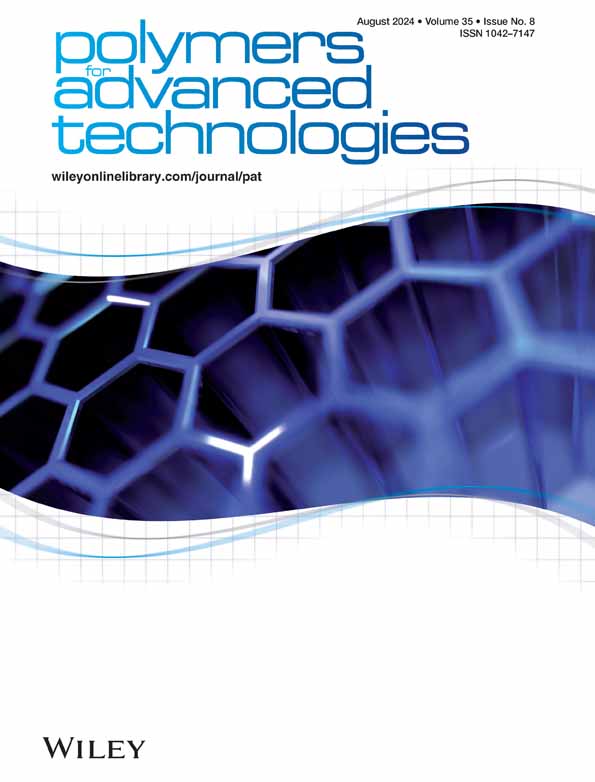Synthesis, characterization, and optimization of dual‐responsive PAMAM nanodendrimers for improved dispersive solid‐phase extraction of cancer agents from complex biological samples
IF 3.4
4区 工程技术
Q2 POLYMER SCIENCE
引用次数: 0
Abstract
Levels of anticancer agents in cancer patients' body fluids are typically measured to adjust drug dosages or improve treatment results. The goal of this research is to present a new method for extracting bicalutamide (BCT) from biological samples using a responsive polymeric nanoadsorbent that reacts to temperature and near‐infrared radiation (NIR). To achieve this, the surface layers of tungsten disulfide nanosheets are modified using poly (N‐vinylcaprolactam) and three generations of polymeric dendrimers. The adsorbent product is then characterized using thermogravimetric analysis, Fourier transform infrared spectroscopy, field emission scanning electron microscopy, and X‐ray diffraction techniques. The drug loading operation on the proposed adsorbent is studied through central composite design and response surface strategy, with optimization for temperature (25–45°C), pH (5–9), and contact time (2–18 min). Nonlinear kinetic and adsorption isotherm analysis results show the best fit with Langmuir and pseudo‐second‐order models. The drug release process from the BCT‐loaded adsorbent is investigated via an HPLC‐UV system under both NIR‐irradiated and non‐irradiated conditions. The suggested method demonstrates remarkable recovery rates for BCT spikes from urine (95.23%) and plasma (93.33%), respectively. Overall, the recommended strategy can be regarded as a potent analytical tool for evaluating BCT in complex biosamples.双响应 PAMAM 纳米树枝状聚合物的合成、表征和优化,用于改进从复杂生物样品中分散固相萃取癌症制剂的方法
测量癌症患者体液中的抗癌药物水平通常是为了调整药物剂量或改善治疗效果。本研究的目的是提出一种新方法,利用一种对温度和近红外辐射(NIR)有反应的聚合物纳米吸附剂从生物样本中提取比卡鲁胺(BCT)。为此,使用聚(N-乙烯基己内酰胺)和三代聚合物树枝形分子对二硫化钨纳米片的表层进行了修饰。然后使用热重分析、傅立叶变换红外光谱、场发射扫描电子显微镜和 X 射线衍射技术对吸附剂产品进行表征。通过中心复合设计和响应面策略,对温度(25-45°C)、pH 值(5-9)和接触时间(2-18 分钟)进行了优化,从而研究了拟议吸附剂上的药物负载操作。非线性动力学和吸附等温线分析结果表明,Langmuir 模型和伪秒阶模型的拟合效果最佳。在近红外辐照和非辐照条件下,通过 HPLC-UV 系统研究了 BCT 吸附剂的药物释放过程。所建议的方法分别从尿液(95.23%)和血浆(93.33%)中回收了 BCT 药物。总之,所推荐的方法可被视为评估复杂生物样品中 BCT 的有效分析工具。
本文章由计算机程序翻译,如有差异,请以英文原文为准。
求助全文
约1分钟内获得全文
求助全文
来源期刊

Polymers for Advanced Technologies
工程技术-高分子科学
CiteScore
6.20
自引率
5.90%
发文量
337
审稿时长
2.1 months
期刊介绍:
Polymers for Advanced Technologies is published in response to recent significant changes in the patterns of materials research and development. Worldwide attention has been focused on the critical importance of materials in the creation of new devices and systems. It is now recognized that materials are often the limiting factor in bringing a new technical concept to fruition and that polymers are often the materials of choice in these demanding applications. A significant portion of the polymer research ongoing in the world is directly or indirectly related to the solution of complex, interdisciplinary problems whose successful resolution is necessary for achievement of broad system objectives.
Polymers for Advanced Technologies is focused to the interest of scientists and engineers from academia and industry who are participating in these new areas of polymer research and development. It is the intent of this journal to impact the polymer related advanced technologies to meet the challenge of the twenty-first century.
Polymers for Advanced Technologies aims at encouraging innovation, invention, imagination and creativity by providing a broad interdisciplinary platform for the presentation of new research and development concepts, theories and results which reflect the changing image and pace of modern polymer science and technology.
Polymers for Advanced Technologies aims at becoming the central organ of the new multi-disciplinary polymer oriented materials science of the highest scientific standards. It will publish original research papers on finished studies; communications limited to five typewritten pages plus three illustrations, containing experimental details; review articles of up to 40 pages; letters to the editor and book reviews. Review articles will normally be published by invitation. The Editor-in-Chief welcomes suggestions for reviews.
 求助内容:
求助内容: 应助结果提醒方式:
应助结果提醒方式:


